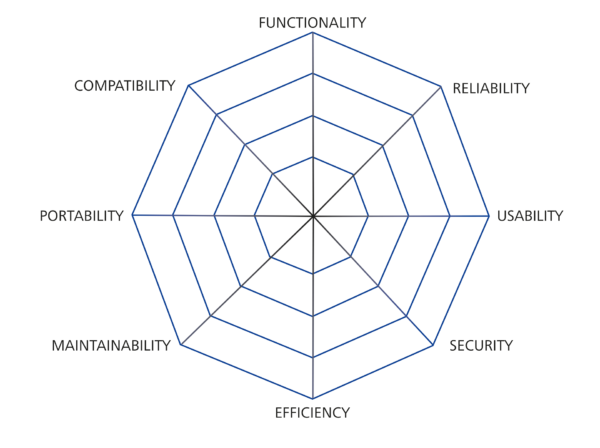In my blog post “The QA Navigation Board – What do you mean, we have to test that?”, I introduced the QA Navigation Board. Now, I would like to share our experience using the QA Octant contained in this QA Navigation Board to identify the necessary types of tests.
One of the questions asked at the start of a software project is: Which quality characteristics does the development, and therefore the quality assurance, focus on? To facilitate the introduction of this topic to the teams, we use the QA Octant. The QA Octant contains the quality characteristics for software systems according to ISO 25010. These characteristics also point to the necessary types of tests that result from the set weighting of the different functional and non-functional characteristics.
Depending on how much the implemented requirements affect the quality characteristics, it is necessary to check these characteristics by means of a corresponding type of test. Apps with a high data throughput for example require efficiency tests, whereas web shops should be tested for compatibility in various browsers. Thanks to the simple visualization and weighting of the different quality characteristics, the QA Octant can be used for planning.

The team asks the product owner or the department: “How important is each of the quality characteristics?” The goal of this round of questions is to visualize a ranking in the weighting of the different characteristics. Most of the respondents will not really differentiate between the quality characteristics, or rather they will answer: “Everything is important!”
It is now up to the team and the host of the meeting to clarify the question to the point that such a differentiation is possible. Different questioning techniques can be used for this purpose.
Differentiation is for example possible by delimiting the area of application. If an HTML-based technical application is used in a company network, and the IT compliance regulations specify one browser and one operating system version, the aspect of compatibility and the associated tests can be ranked lower. If, by contrast, a large number of different combinations of platforms are used, extensive testing has to be planned.
For further differentiation, you can for example use a negative questioning technique: “What happens if, for example, usability is reduced?” Using the example of an application for monthly invoicing, we assume that a negative effect on the usability increases the time it takes to issue an invoice from two to four hours. Since the application is only used once every month, this “delay” would be acceptable, and usability can be ranked lower in the QA Octant.
This questioning technique can be expanded by prioritizing by means of risk assessment. “What happens, or which consequences arise if, for example, the security characteristic is lowered?” The answers result from the following aspects:
- What financial impact would a failure of the application have if the focus on this characteristic was reduced?
- How many users would be affected by a failure of the application if the focus on this characteristic was reduced?
- Would a failure of the application cause danger to life and limb if the focus on this characteristic was reduced?
- Would a failure of the application affect the company’s reputation if the focus on this characteristic was reduced?
If results and findings are available with respect to one or several of the quality characteristics, you can compare them to the open quality characteristics and proceed similarly to the complexity comparison for the planning or estimation.
Asking the right questions produces an overview of the quality characteristics. Thanks to the simple visualization and weighting of the different quality characteristics, the QA Octant can be used for planning the types of tests.
The result is not always the most important part of the QA Octant: “the journey is the destination” as well. Due to the weighting in the team and together with the PO and/or the department, different opinions are more discernible, and all the parties involved develop a better understanding.